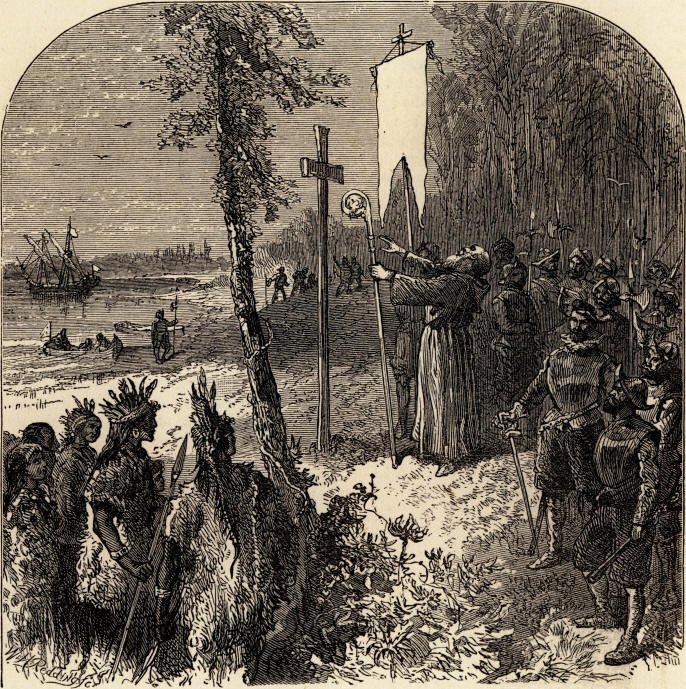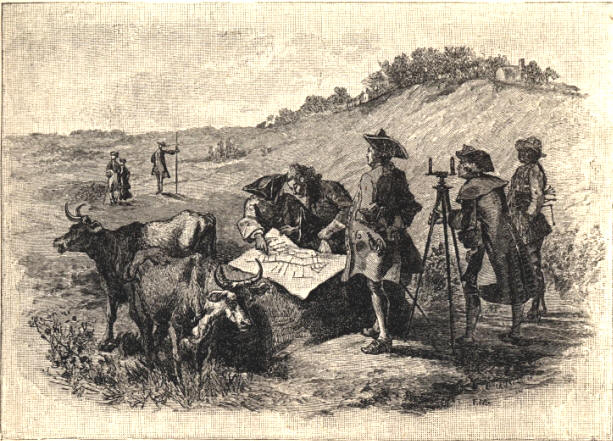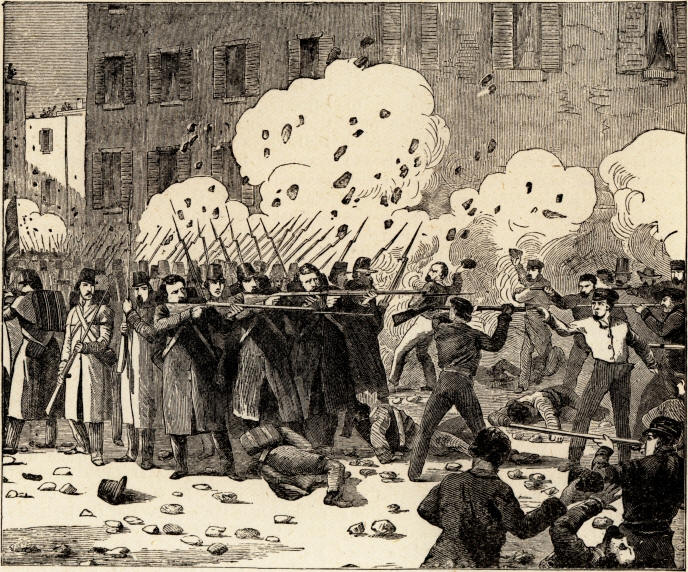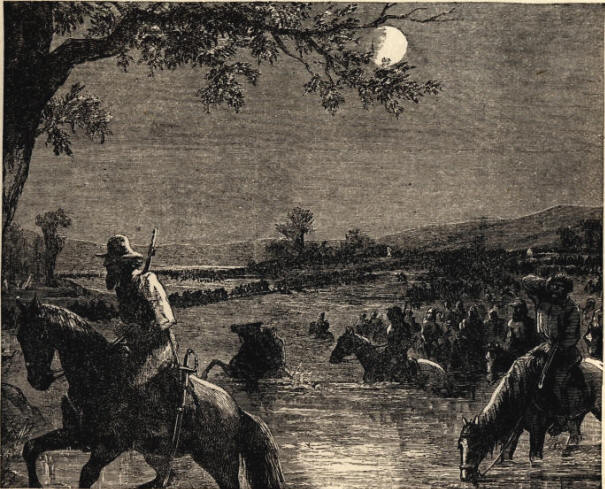Maryland
|
|
This Site:
|
Map of the Maryland Colony
Colony Thrives Under Religious Toleration
THE LANDING ON BLACKSTONE ISLAND.The governor made further explorations, and, finally, on March 27 (0. S.), Calvert, having. entered into a treaty for the purchase of a domain on a pleasant little river, determined there to plant a settlement. With imposing religious ceremonies it was dedicated to the Virgin Mary, and the place was called St. Mary. It was near the entrance of the Potomac into Chesapeake Bay. A year afterwards, they established their capital at St. Mary, and a legislative assembly composed of the whole people - a purely democratic legislature - met there. As their ranks increased by emigration this method was found inconvenient, and in 1639 a representative government was established, the people being allowed to send as many delegates as they pleased. So was founded the commonwealth of Maryland. Rebellion in MarylandClaiborne, the first settler, refused to acknowledge the new government, and was finally expelled from Kent Island. Under the charter, Lord Baltimore had the power of enacting all necessary laws for the colony " with the advice, consent, and approbation of the freemen of the province " or their representatives convened in general assembly; but in the first Assembly (1635) a dispute arose respecting the right of initiating legislation. The contention continued until 1638, when Lord Baltimore yielded the right to the Assembly. The first statutes of Maryland were enacted in 1639. In 1642 a company of Puritans, who had been driven out of Virginia, settled in Maryland, and soon showed a spirit of resistance to the authorities. Claiborne, who had been deprived of his property and civil rights by the legislature of Maryland, now reappeared at Kent Island and stirred up the Indians with jealousy of the colonists, and they made war upon the settlers. It was not long nor very distressing, and it was just ended (1645) when Claiborne, by false representations, fanned the embers of discontent into a flame of civil war. The insurgents, with disaffected Indians, drove the governor and his council into Virginia, and for about a year and a half the rebels held the reins of power. The rebellion was crushed in the summer of 1647, when the governor returned (in August) and resumed his chair. Many of the records had been destroyed in the turmoil, and a greater portion were carried into Virginia and lost. In 1649 an important law called the toleration act was passed, which simply reaffirmed the provisions of the charter concerning religious freedom. The Puritans in Maryland called their chief settlement Providence, which was afterwards changed to Annapolis. Leonard Calvert died in 1647, and was succeeded by Thomas Greene; but on the death of the King (1649), Lord Baltimore professed to be a Protestant, and appointed William Stone, of Virginia, a warm friend of Parliament and a Protestant, governor. The Parliament, not having confidence in Lord Baltimore's professions, removed Stone from office and appointed commissioners to administer the government. Claiborne was one of them, so also was Governor Bennet, of Virginia. These commissioners entered upon their duties with a high hand. They removed Governor Stone, took possession of the records, and abolished the authority of Lord Baltimore. So the " outlaw " trampled on his old enemy. A few months later they reinstated Stone, and put Kent and Palmer's islands into the possession of Claiborne again. On the dissolution of the Long Parliament (1653), Cromwell restored Lord Baltimore's power as proprietor, and Stone proclaimed the actions of the commissioners rebellious. The incensed commissioners returned to Maryland and compelled Stone to surrender his office; then they vested the government in a board of ten commissioners. Civil and religious disputes now ran high. The Puritans, being in the majority in the Assembly, passed an act disfranchising the Roman Catholics and members of the Church of England. These narrowminded bigots flogged and imprisoned Quakers, and tried to hold sway as their coreligionists did in Massachusetts. Baltimore appealed to Cromwell, and the latter sent word to the commissioners in Maryland not "to busy themselves about religion, but to settle the civil government." So encouraged, Baltimore directed Stone to raise an army for the restoration of the authority of the proprietor. He obeyed. Stone's forces were mostly Roman Catholics. He seized the colonial records, resumed the office of governor, and inaugurated civil war. A sharp and decisive battle was fought near Providence (Annapolis) early in April, 1655, when many of Stone's party were killed or taken prisoners, and he was defeated and became a captive. His life was spared, but four others were executed, having been convicted of treason. Anarchy reigned in Maryland for several months, when Lord Baltimore appointed Josiah Fendall, a former insurgent, governor. For two years longer there was bitter strife between the people and the agent of the proprietor. The latter finally made important concessions to the popular demands. Fendall acted discreetly, and there was comparative quiet in the colony until the death of Cromwell. In the spring of 1660, the people, boldly asserting popular supremacy, assumed the legislative powers and gave Fendall a commission as governor. The restoration of monarchy in England soon afterwards led to the reinstatement of Lord Baltimore in his rights, and Fendall was found guilty of treason because he had accepted office from a " rebellious Assembly." Baltimore proclaimed a general pardon of all political offenders, and for thirty years afterwards Maryland enjoyed repose. Lord Baltimore died in 1675, and was succeeded by his son Charles; and he and his successors continued to administer the government of the province, with a few interruptions, until the Revolutionary War. The revolution in England (1678) shook the colony. The deputy governor hesitated to proclaim William and Mary, and a restless spirit named Coode made this a pretext for exciting the people by giving currency to a story that the local magistrates and the Roman Catholics were about to join the Indians and exterminate the Protestants. The old religious feud instantly flamed out with intensity. The armed Protestants, led by Coode, took forcible possession of the capital of the province (September, 1689), and assumed the administration of the government. They called a convention, invested it with legislative functions, and by that body public affairs were managed until June, 1691, when the sovereign of England, ignoring the rights of Lord Baltimore, made Mary-land a royal province, with Lionel Copley governor. In 1694 the capital of the province was transferred from St. Mary to the town soon afterwards named Annapolis, where it yet remains. The proprietary rights of Baltimore (Benedict Leonard Calvert) were restored to his infant son and heir (Charles) in 1716, and the original form of government was reestablished. So it remained until the Revolutionary War. Baltimore is Created
Laying Out BaltimoreThe city of Baltimore was created by act of the Assembly, Aug. 8, 1729, and named in honor of Cecil Calvert, Lord Baltimore. The town was laid out January 12, 1730. Population in 1752 was 200; in 1790, 13,503; in 1890, 434,439; in 1900, 508,957. War of 1812Maryland was disposed to be very conservative on the question of independence. Its convention voted, May 20, 1776, that it was not necessary to suppress every exercise of royal authority. Several intercepted letters, written by Governor Eden, which had just come to light, caused Congress to recommend his arrest. The Baltimore committee volunteered in the matter, but became involved, in consequence, in a collision with the provincial convention. A committee of that body reported, on investigation, that the governor, in his correspondence with the British ministry, had not acted in a hostile character; but, at the same time, it was voted to signify to Governor Eden that the public safety and quiet required him to leave the province, which he did. While stirring events were occurring on the New England coast and the Northern frontier in 1814, others of equal importance occurred in the vicinity of Chesapeake Bay and the national capital. There were premonitions of impending danger in that region early in 1814. News reached the government that 4,000 British troops, destined for the United States, had landed at Bermuda. This news was followed by the arrival, in Lynn Haven Bay, of Admiral Cockburn, with a strong naval force, to begin the work indicated in Admiral Cochrane's order to " destroy the seaport towns and ravage the country." In April news came of the downfall of Napoleon and of his abdication, which was expected to release British veterans from service in Europe. Notwithstanding the national capital was then almost defenseless, the passage of the British ships up the Potomac might be disputed only by the guns of Fort Washington, a few miles below the city, and there was little force to obstruct the passage of land troops across Maryland from the Chesapeake. On July 1 official intelligence reached the President that " a fleet of transports, with a large force, bound to some port in the United States, probably on the Potomac," was about to sail from Bermuda. In the military district of which the District of Columbia formed a part there were only a little more than 2,000 effective men, under General Winder, and these were scattered at points some distance from each other. There was a company of marines at the barracks at Washington, and a company of artillery at Fort Washington. With all this knowledge of weakness and impending danger, the Secretary of War, whose opinions governed the President and cabinet, could not be persuaded that the capital was likely to receive any harm. The government organ, the National Intelligencer, boasted that any British force that might come could be easily driven away. The folly of this boast was soon made manifest by sad events. General Winder continually warned the government
of danger; and when danger actually appeared he was placed, by
official orders, at the head of 15,000 militia for the defense of
the capital. This army was on paper only. The militia lay hidden in
official orders; and when, at the middle of August, a powerful
British land and naval force appeared in Chesapeake Bay, Winder had
only a handful of men with which to defend the capital. The call for
the militia was tardily answered, for they feared the loss of their
slaves if the masters should leave the plantations. There was
widespread alarm over Mary-land and Virginia. At that juncture
Commodore Barney, with an armed schooner and fifteen barges, was in
the Patuxent River, near its mouth. He fled up the stream to avoid
attack by British vessels. The latter landed a strong force, under
General Ross, and pushed on towards Washington. Winder issued
stirring appeals for the militia to turn out, and asked General
Smith, of Baltimore, to turn out his brigade. The British pursued
Barney and caused the destruction of his flotilla. Pressing on
towards the capital, they were met by troops under Winder at
Bladensburg, when a severe engagement ensued, which resulted in
victory for the invaders. Then they marched on Washington, set fire
to its public buildings, and gave the town up to plunder. Only the
Patent Office building was saved. The vessels and other public
property at the navy-yard were destroyed by the Americans to prevent
them falling into the hands of the British. The total value of the
property annihilated by the Americans and British at that time was
estimated at about $2,000,000. Maryland in the Civil WarIt was very important in carrying out the plan of the Confederates, early in 1861, to seize the national capital, to have the authorities of the State of Maryland in accord with the movement. Emissaries and commissioners from the cotton-growing States were early within its borders plying their seductive arts; and they found in Baltimore so many sympathizers among leading citizens that, for a while, they felt sure of the cooperation of Maryland. In the governor, Thomas H. Hicks, however, they found a sturdy opponent of their schemes. It is said that on January 1, 1861, there were no less than 12,000 men organized in that State, bound by solemn oaths to follow their leaders in seizing Washington, D. C. Against such an array, against the natural sympathy of blood-relationship with the Southern people, and against the seeming self-interest of the holders of 700,000 slaves, valued at $50,000,000, which property might be imperilled, they thought, by alliance with the North, Governor Hicks manfully contended. He was supported by an eminently loyal people among the so-called " masses." Hicks was urged by the Confederates to call a meeting of the legislature to consider the state of affairs; but he too well knew the danger that would attend the gathering of a body largely made up of slave-holders, and he steadily refused to make the call. In fact, he had been informed that the members of the legislature had already formed a plan for "carrying Maryland out of the Union," and resolutions to that effect had already been drawn. These facts he set forth in an address to the people of his State, Jan. 6, 1861, which delighted the Unionists. Already the late Henry Winter Davis, a Representative of the Baltimore district in Congress, had published (January 2, 1861) a powerful appeal against the calling of a meeting of the legislature, or the assembling of a Border State convention, as had been proposed. The Confederates denounced Hicks as a traitor, and tried every means to counteract his influence, but in vain. A strong Union party was organized. Maryland became the great battlefield of opposing opinion. The Union men triumphed; and within the space of four years slavery was abolished in Maryland, not only by the Proclamation of Emancipation, but by the constitutional act of its own authorities.
Battle in the Streets of BaltimoreFor a while after the attack on Massachusetts troops in BALTIMORE, the Unionists of Maryland were almost silenced. The legislature was filled with disloyal men. Abettors of the mob in Baltimore, who were members of the legislature, proposed laws to shield the rioters from harm. S. T. Wallis proposed for that purpose, " That the measures adopted and conduct pursued by the authorities of the city of Baltimore on Friday, April 19, and since that time, be and the same are hereby made valid by the General Assembly." This would cover the disloyal acts of the mayor, the chief of police, the murderous rioters, and the bridgeburners. To further shield the offenders, T. Parkins Scott offered in the same body a bill to suspend the operations of the criminal laws, and that the grand jury should be stopped from finding indictments against any of the offenders. These measures alarmed the best friends of the commonwealth, and added strength to the sympathy for the Union cause in that State. When General Butler, by a single, bold stroke, revealed the real weakness of the Confederate element in Maryland, the Unionists breathed freer, and very soon manifested their strength. Habeas Corpus SuspendedMay 14, 1861, was a memorable one in the annals of Maryland. On that day the legislature adjourned, and Governor Hicks, relieved of the presence of the Confederate element, and assured by the Secretary of War that National troops would remain in Maryland as long as seeming necessity demanded their presence, issued a proclamation calling for Maryland's quota of troops (four regiments) in response to the President's call. On that day the veteran Major W. W. Morris, commander of Fort McHenry, first gave practical force to the suspension of the privilege of the writ of habeas corpus which the exigency of the times gave constitutional sanction for. A man claiming to be a Maryland soldier was imprisoned in Fort McHenry. A Baltimore judge issued a writ of habeas corpus for his release. Morris refused to obey, saying, in a letter: "At the date of issuing your writ, and for two weeks previous, the city in which you live and where your court has been held was entirely under the control of revolutionary authorities. Within that period, United States soldiers, while committing no offence, had been perfidiously attacked and inhumanely murdered in your streets; no punishment had been awarded, and, I believe, no arrests had been made for these atrocious crimes; supplies of provisions intended for this garrison had been stopped; the intention to capture this fort had been boldly proclaimed; your most public thoroughfares had been daily patrolled by large numbers of troops armed and clothed, at least in part, with articles stolen from the United States, and the federal flagg, while waving on the federal offices, was cut down [by order of the chief of police Kane] by some person wearing the uniform of a Maryland soldier. To add to the foregoing, an assemblage elected in defiance of law, but claiming to be the legislative body of your State, and so recognized by the executive of Maryland, was debating the federal compact. If all this be not rebellion, I know not what to call it. I certainly regard it as sufficient legal cause for suspending the privilege of the writ of habeas corpus." Robert E. Lee Invades MarylandAt the request of the governors of many States the President, on July 1, 1862, called for 300,000 volunteers to serve during the war; and in August he called for 300,000 more for three months, with the understanding that an equal number would be drafted from the citizens who were between eighteen and forty-five years of age, if they did not appear among the volunteers. These calls were cheerfully responded to; and the Confederate government, alarmed, ordered General Lee to make a desperate effort to capture the national capital before the new army should be brought into the field. Lee perceived that it would be madness to make a direct attack upon its formidable defenses, so he resolved to cross the Potomac with a large force into Maryland, assail Baltimore, and, if successful, to fall upon Washington in the rear. He believed the people of Maryland were chafing under the dominion of the national government; that they were eager to aid the Confederate cause; and that the presence of his army on the soil of Maryland would cause an immediate and almost universal uprising in favor of the Confederacy. Lee was joined, September 2, 1862, by the fresh division of General D. H. Hill. This was sent as a vanguard to Leesburg, Virginia. The whole Confederate army followed, and between the 4th and 7th crossed the Potomac at the Point of Rocks, and encamped not far from the city of Frederick, on the Monocacy River. There General Lee, on the 8th, issued a stirring appeal in the form of a proclamation to the people of Maryland. He was sorely disappointed. Instead of a general uprising in his favor, he lost more men by desertions than he gained by accessions. When General McClellan heard of this invasion, he left General Banks with some troops at Washington, and with about 90,000 men crossed the Potomac above Washington and advanced cautiously towards Frederick. At McClellan's approach Lee withdrew. There the plan for seizing Washington was discovered. It was to take possession of Harper's Ferry and open communication with Richmond, by way of the Shenandoah Valley, and then, marching towards Pennsylvania, entice McClellan's forces in that direction. At a proper time Lee was to turn suddenly, defeat his antagonist, and then march upon Washington. See SOUTH MOUNTAIN. After the battle at CHANCELLORSVILLE Lee's army was strong in material and moral force. Recent successes had greatly inspirited it. It was reorganized into three army corps, commanded respectively by Generals Longstreet, A. P. Hill, and Ewell. At no time, probably, during the war was the Confederate army more complete in numbers, equipment, and discipline, or furnished with more ample materials for carrying on the conflict, than it was at the middle of June, 1863, when Lee invaded Maryland. According to Confederate official returns, there were at least 500,000 men on the army rolls, and more than 300,000 "present and fit for duty." Richmond seemed secure from harm. Vicksburg and Port Hudson, on the Mississippi, seemed impregnable against any National forces that might be employed against them. Their European friends gave them great encouragement, for there were strong manifestations of desires for the acknowledgment of the independence of the "Confederate States of America." Feeling thus strong, the Confederate authorities ordered Lee to invade Maryland and Pennsylvania. His force was now almost equal to that of Hooker, and in better spirits than was the Army of the Potomac. As early as May 20 Hooker suspected such a movement would be undertaken, and informed the Secretary of War. Earlier than this, Clement C. Barclay, of Philadelphia, who had rare opportunities for information, had warned the authorities at Washington, Baltimore, and Harrisburg of impending danger, but they were slow to believe Lee would repeat the folly of the previous year. Lee's first movement in that direction was to get Hooker from the Rappahannock by feints and a real flanking movement. There was considerable preliminary cavalry skirmishing early in June, and finally a cavalry reconnaissance by Pleasonton revealed the fact of Lee's grand movement. Hooker supposed he would follow his route of the previous year, and was watching and guarding the fords of the Rappahannock, when Lee projected his right wing, under Ewell, through the Blue Ridge into the Shenandoah Valley at Strasburg. He pushed down the valley to Winchester, where General Milroy was in command of nearly 10,000 men, on the evening of June 13, having marched 70 miles in three days. It was a bold movement. Milroy called in his outposts and prepared to fight, but before daybreak he resolved to retreat. He spiked his cannon, drowned his powder, and was about to depart, when the Confederates fell upon him.
Confederates Crossing the PotomacThen began a race towards the Potomac, but the Nationals were stopped by a force some miles from Winchester, and many of them made prisoners. The garrison at Harper's Ferry fled across the river to Maryland Heights. Informed of Lee's movement, Hooker moved rapidly northward, intent upon covering Washington, while his cavalry watched the passes of the Blue Ridge. The national authorities, as well as those of Maryland and Pennsylvania, were thoroughly aroused by a sense of danger. The President called (June 15) upon the States nearest the capital for an aggregate of 100,000 militia; and the governor of Pennsylvania called out the entire militia of the State. Lee had about a week the start of Hooker in the race for the Potomac. On the 15th 1,500 Confederate cavalry dashed across the Potomac at Williamsport, in pursuit of Milroy's wagon-train; swept up the Cumberland Valley to Chambersburg, Pa.; destroyed the railroad in that vicinity; plundered the region of horses, cattle, and other supplies; and, with fifty kidnapped negroes, going back to Hagerstown, waited for Lee. The information procured by the raiders satisfied Lee that he should not meet with much opposition, and he pressed forward. Ewell's corps crossed the Potomac at Williamsport, near Shepherds-town, on June 21 and 22, and swept on to Chambersburg, and thence to the Susquehanna, opposite Columbia, levying contributions on the people. The greatest alarm everywhere prevailed. It was believed that Harrisburg and Philadelphia would soon be entered by the Confederates, and vast quantities of valuable property were sent north from the latter city for safety. Even New York seemed menaced. The remainder of Lee's army crossed the Potomac on the 24th and 25th, and pressed on after Ewell towards the Susquehanna. Hooker's army, now fully 100,000 strong, crossed the river at Edwards's Ferry. Regarding Harper's Ferry, at that moment, of little account, he asked for the abandonment of that vicinity by 11,000 National troops. The general-in-chief (Halleck) would not consent, and Hooker, at his own request, was at once relieved of his command, and was superseded by General George C. Meade on June 28. At the beginning of July, 1864, Maryland was invaded by the Confederates for the third time. The Confederate General Early had been gathering troops for the purpose in the Shenandoah Valley, and with from 15,000 to 20,000 men, of all arms, he swept rapidly down the valley towards Williamsport. General Sigel, too weak to resist, fled into Maryland, with a heavy loss of stores, and General Weber, in command at Harper's Ferry, retired to Maryland Heights. Early crossed the Potomac at Williamsport, and pushing on to Hagerstown, July 6, 1864, levied a contribution on the inhabitants there of $20,000. Then he hastened on to Frederick, on the Monocacy River, and threatened both Baltimore and Washington. The raid had a twofold purpose - to draw troops from before Petersburg for the defense of Washington, and to plunder. When informed of it, General Grant sent the 6th Corps to protect Washington. Meanwhile General Lew Wallace (then in command of the Middle Department, with his headquartersi n Baltimore) had proceeded from that city, with a few troops hastily collected, to confront the invaders. General E. B. Tyler was then at the railway bridge over the Monocacy with about 1,000 men. Wallace went to Tyler's camp, saw the necessity for prompt and energetic action, and chose a commanding position on the east side of the Monocacy for the concentration of his forces. On the 9th he fought the hosts of Early desperately not far from Frederick. He had been joined by a portion of Rickett's brigade, from the advance of the 6th Corps. This handful of men, after fighting overwhelming numbers eight hours, was defeated, with heavy loss, when Early pushed on towards Washington. The vanquished Nationals had really won a, victory, for they had detained the Confederates long enough that evening to allow the 6th and 19th Corps to reach and secure the national capital. When Early perceived this he pushed across the Potomac at Edwards's Ferry with a large amount of plunder, closely pursued by General Wright to the Shenandoah Valley. He was struck by the Nationals at Snicker's Ferry and at Snicker's Gap, and sharp skirmishes ensued. At Ashby's Gap there was also a brisk skirmish, and in two encounters the Nationals lost about 500 men. Early moved up the valley as if continuing his retreat, when General Wright, handing his command over to General Crook, returned to Washington. Meanwhile General Averill, with a considerable force, moved towards Winchester, and near that place he fought the Confederates, July 20, three hours. They lost 400 men (about 200 of them made prisoners), with four guns. Averill's loss was about 200. It was supposed Early was moving up the valley, but Crook, marching from Harper's Ferry to Winchester, soon afterwards encountered him in heavy force, and he was driven back, July 23, to Martinsburg, with a loss of 1,200 men. Early sent 3,000 cavalry, under General McCausland, to make a plundering and devastating raid in the direction of the Susquehanna. They swept over the country in eccentric lines, bewildering its defenders, and on July 30 entered the defenseless and partly deserted village of Chambersburg, Pa., and demanded of the inhabitants $200,000 in gold or $500,000 in " greenbacks " (paper currency) as a tribute to insure the town against destruction. The tribute was not offered, and two-thirds of the town was laid in ashes. No time was given for the removal of the sick, infirm, women, or children. General Averill, with 2,600 cavalry, was soon after the raiders. He drove them across the Potomac with such blows that they did not stop to plunder and destroy. Mosby, another guerilla chief, dashed across the Potomac and carried off a few horsemen. Averill pursued the Confederates up the south branch of the Potomac, attacked and defeated them, Aug. 4, 1864, at Moorfield, captured their guns, trains, and 500 men, with a loss to himself of fifty men. Grant now, to protect Washington from seizure, and Maryland and Pennsylvania from invasion, consolidated several departments, calling the organization the Middle Division. General Sherman was assigned to its command, Aug. 7, 1864, and at once entered upon his duties, at the head of over 30,000 troops.
|
||||||||||||||||||||||||||||||||||||||||||||||||||||||||||||||||||||||||||||||||||||||||||||||||||||||||||||||||||
|
|
||
|
|
Site Copyright 2003-2018 Son of the South. For Questions or comments about this collection, contact: paul@sonofthesouth.net |
|
|
Are you Scared and Confused? Read My Snake Story, a story of hope and encouragement, to help you face your fears. |
||
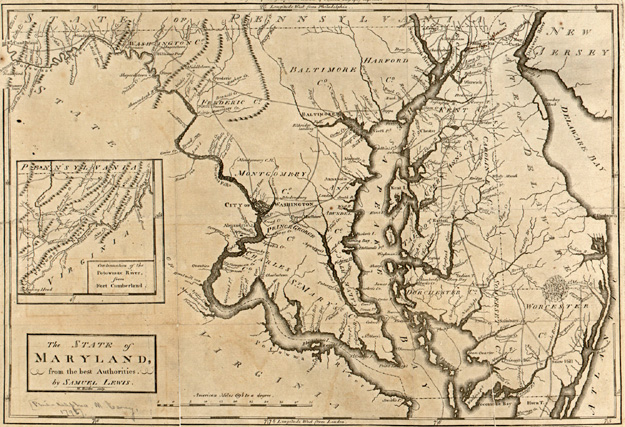
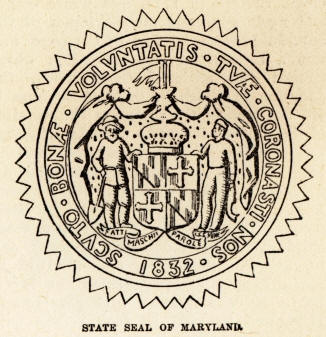 Maryland,
Colony OF, one of the
Maryland,
Colony OF, one of the
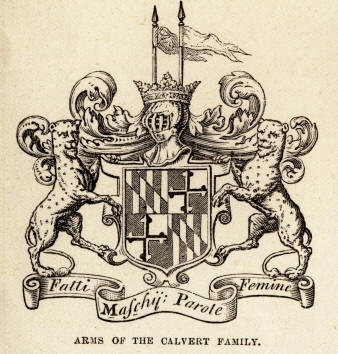 This
toleration promoted the growth of the colony, and persecuted people
found a refuge there. Armed with this charter, young
This
toleration promoted the growth of the colony, and persecuted people
found a refuge there. Armed with this charter, young
